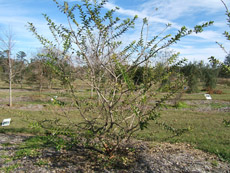Chionanthus retusus (Chinese Fringetree)

*Click on picture for more images of this species.
- USDA Hardiness Zone: 5B - 9B
- Mature Height: 15 to 20 ft
- Mature Spread: 15 to 25 ft
- Growth Rate: Slow
- Availability: Somewhat available as small trees
- Drought Tolerance: Moderate
- Salt Tolerance: Unknown
- Light Requirements: Full sun to partial shade
- Native Origin: Not native to North America. Invasive potential has not been assessed.
- Soil Drainage: Tolerates well-drained sites to occasionally wet sites.
- Foliage: Deciduous tree with no showy fall color.
- Flowers: White, extremely showy, fragrant flowers in the spring.
- Pests: Generally insect free, but mites may infest the foliage. The main diseases are leaf spots, powdery mildew and stem canker.
Description: It is hard to think of a more beautiful, small, 20-foot-tall tree than Chinese Fringetree when it is in full bloom. The pure white, fragrant flowers, emerging just as the dogwood flowers fade, hang in four-inch-long, spectacular terminal panicles which appear to cover the tree with snowy white cotton for two to three weeks. Flowers emerge at the terminal end of the spring shoot growth flush. This differs from the native Fringetree which flowers before leaves emerge. As with other white- flowered trees, Chinese Fringetree looks best when viewed against a dark background.
Female plants develop purple/blue fruits which are highly prized by many birds. Fall color is muted yellow in northern climates, but is often an unnoticed brown in Florida, with many leaves dropping to the ground a blackened green. It forms an open round ball if left unpruned but can be trained into a small tree with lower branches removed. It is naturally multi-trunked and is usually found this way in nurseries but can be trained into a small, single-trunked specimen. It is probably one of the finest accents available in the nursery trade! It makes the perfect patio tree, or can be planted along streets if provided with occasional summer irrigation.
Although reportedly difficult to transplant, Chinese Fringetree can be successfully moved quite easily with proper care. It is usually grown and sold in containers. Chinese Fringetree looks best in a sunny spot sheltered from wind. The tree appears more attractive in the deep south when grown with several hours of shade but blooms best in full sun, on moist, acid soil, and will gladly grow in even wet soils. Chinese Fringetree grows very slowly, usually 4 to 10 inches per year, but can grow a foot per year if given rich, moist soil and plenty of fertilizer. Fringetree tolerates moderate drought but looks best if irrigated occasionally during extended summer drought.
Gainesville Observations: This tree is the show stopper in mid- to late-March in the test plots. In flower, the trees stand out above all else. The tree is also attractive when not in flower due to glossy dark green leaves. Trees we secured for this test were multi-trunked and not pruned to a central leader so we have been challenged with developing descent structure in the trees. We have been structural pruning to reduce growth rate on all but one leader so we can create clearance beneath the canopy. From what I have seen this will be possible and I think Chinese fringetree can be pruned to a central leader in the nursery. In contrast to the native fringetree, Chinese Fringetree could make a descent street tree.
Fact Sheet (pdf)
Click here for more photos of this tree.

